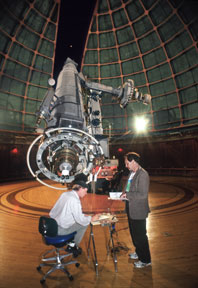What was on the minds of everyone that summer of 1894, was the question: what were the canals of Mars?
What would Lowell's much-publicized observing expedition to Arizona reveal about the planet? What indications would turn up relevant to the burning question of life -- even intelligent life -- on the planet? What would the great refractor of the Lick Observatory show?
Lowell gave a talk at the Boston Scientific Society meeting a week before heading to Flagstaff in which he clearly stated that he expected Schiaparelli's canals would turn out to be signs of intelligent life on the planet. Reading his text, one realizes that his dome was not the only part of his expedition that was prefabricated. Not surprisingly, in light of that pre-observational disclosure, he went on to cobweb the disk of Mars with canals. Based on his first season on Mars's Hill, he returned to Boston to write his best-selling book, Mars, published at the end of 1895, in which he spelled out his theory of the dying desert planet. It has become one of the tropes of science-fiction literature. According to Lowell, Mars, being smaller, cooled more quickly than the Earth. It had run on ahead of the Earth in the journey of a planet's life, and was a dried and shriveled world, a desert whose only water-supply was locked up in the ice caps at the poles. Each spring and summer, as the caps melted, the water began to flow. The Martians, in order to stave off inevitable doom by desiccation, temporarily forestalled their desperate situation by building engineering works -- a planet-wide system of irrigation canals.
Like Schiaparelli, Lowell had what might be described as a literary-mathematico-deductive mind. In addition to Lowell's noted literary achievements, he was mathematician enough to later carry out the investigation of the errant motion of Uranus, which led to a search for "Planet X" and that culminated in the serendipitous discovery of Pluto by Clyde Tombaugh in 1930. Both Schiaparelli and Lowell approached Mars as a potential body of knowledge to be classified, described, and named. Barnard, on the other hand had the mind of a visual artist, approaching it as something to be seen.
At the telescope, eyes differ only a little, minds much. When one looks at the surface of a planet like Mars, how does one approach it? What does one look for, how does one see?
|
